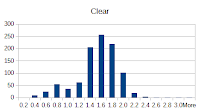He is a ruler who governs himself, never needing to ask anyone’s permission.
—from ‘Arrakis Awakening’ by the Princess Irulan

Remarkable, Incredible and Amazing nerdiness
He is a ruler who governs himself, never needing to ask anyone’s permission.
—from ‘Arrakis Awakening’ by the Princess Irulan
When looking at Arena and Wilderness Encounters and for h in hexes, you start wondering about things like this:-
https://www.redblobgames.com/grids/hexagons/
So thanks very much to redblobgames!
https://deltasdnd.blogspot.com/2021/12/wilderness-simulator-stats.html
https://github.com/danielrcollins1/WildernessEncounterSim

“One more reflection on the Original D&D wilderness encounter charts. Last week we were using some tabulated charts to decide between two possible rules interpretations, and one was clearly much nicer. But that was based on just looking at the average EHD (Equivalent Hit Dice) for each encounter type, which is maybe a little sketchy. Since I’m obsessive about these things, I wrote a simulator program that actually rolls up the individual encounters (varying the number appearing by psuedo-random dice), and I had it spit out a thousand random encounters for each terrain type.”
This all looks like pretty reasonable results to me!
https://github.com/danielrcollins1/Arena
Looking forward to giving this a shot [with hopefully minimal swearing at java]
This code package provides routines for simulating combat in a tabletop Fantasy Role-Playing Game (FRPG) similar to Original D&D or closely-related games. Combat is done as per “theater of the mind” without tracking exact spatial locations; targets of attacks are chosen by random method (as per 1E AD&D DMG). In most cases, the intent here is to output aggregate statistics based on many trials of the game between men and monsters. This package provides only command-line, text output; there are no graphics or visualizations, and generally few options for output regarding individual combats.
For a precompiled JAR executable made from this package, and full JavaDoc pages, visit:
https://whosemeasure.blogspot.com/2021/12/every-goddamn-vampire-in-this-goddamn.html
“I wanted to make a generator that would show you the vampire society of a given city with a single click. But in order to do that, I needed to know how many vampires to put in it. The VtM revised rulebook provides a rule of thumb (that it almost always ignores) saying a densely population area should have one vampire for every 100,000 people in a community. But vampires aren’t lone wanderers. They’re organized in coteries of a size that the book is cagey about telling. A few levels of investigation in, I found myself searching out the metro population of the United States in 1990 to facilitate this growing project. I was no longer trying to generate a city. I was trying to generate every city in the US. I ran the generator once and came up with a vampire census 100 pages long. “
You could borrow this Vampire the Masquerade randomiser for lots of games!
A very cool collection of resources to make maps and add randomly generated content to them :- https://github.com/kensanata/hex-mapping
Also for Traveller.
Possibly holidays could disappear here:…
This and Alex’s other game stuff can be found here:
https://alexschroeder.ch/wiki/RPG
Which can lead you down this enjoyable rabbit hole:
https://cosmicheroes.space/blog/index.php/2019/01/30/old-school-rpg-planet/
A five part series so far:
https://osrsimulacrum.blogspot.com/2021/02/a-historical-look-at-osr-part-i.html
https://osrsimulacrum.blogspot.com/2021/02/a-historical-look-at-osr-part-ii.html
https://osrsimulacrum.blogspot.com/2021/02/a-historical-look-at-osr-part-iii.html
https://osrsimulacrum.blogspot.com/2021/03/a-historical-look-at-osr-part-iv.html
https://osrsimulacrum.blogspot.com/2021/12/a-historical-look-at-osr-part-v.html
This is an excellent overview that many a scholar could jump off from as desired, so thanks
It was by such a fate as this that Muad’Dib met his own destiny. There was no opportunity to prevent this, no chance to save himself. The fall of a statue is an apt metaphor for the fall of a human spirit in his case. When we look at it, do we see a great mountain? Or perhaps a vast and chaotic chasm? Or a small, but solid, mass of stone?
—from ‘Songs of Muad’Dib’ by the Princess Irulan